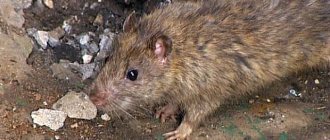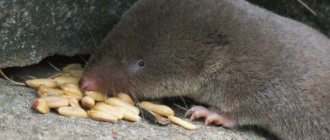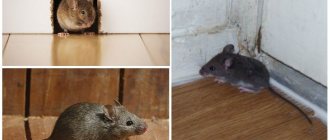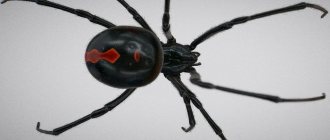Lifestyle
Life of rodents
The black rat becomes active at night. A person determines the presence of a pest in a home by rustling, rat squeaking and scratching sounds.
The lifespan of a rat depends on its habitat:
- in nature, pests live 1-2 years;
- in captivity the animal can live up to four years.
Rodents do not gather in large flocks. They prefer to live in small groups - five to seven individuals. Each clan has a hierarchy. The group includes:
- dominant;
- subdominant;
- subordinate male.
Mammals are able to live in any corner. They build nests in the ceilings of houses, elevator shafts, and attics. The animals drive away individuals that do not belong to the pack from their territory.
Interesting!
People have found rats in freezers. There, rodents built nests from animal tendons.
Black rats are not as aggressive as pasyuki, which fight within the group. When in danger, these rats can even attack humans. The black species prefers to escape. But if he is caught or cornered, he will try to defend himself and attack.
Interesting Facts
The black rat has been known to mankind since the ancient period, and during this time people have collected many interesting stories and facts about these animals. Among them there are several that are simply amazing and even shocking:
- in the Middle East and Mediterranean, the remains of this (or a similar) species of rat were found, which belong to the Pleistocene era and may have lived next to mammoths;
- In China and India, a natural phenomenon called “The Death of Bamboo” is associated with black rats. It lies in the fact that once every 48 years, there is a surge in the population of these rodents and they eat all the fallen bamboo seeds. As a result, the bamboo forest does not grow the next year;
- during the plague pandemic in Europe, the main carriers of the deadly infection were black rats;
- The mythological animal called the "Rat King" has a real-life prototype. In the habitats of black rats, sometimes clusters of rodents are found that are connected by their tails. In this case, the tails of the animals are often broken and damaged. Such “nests” are popularly called “Rat King”. The “Rat Kings” preserved in alcohol were even shown in museums in various European cities. One of the largest “Kings” is considered to be found in the city of Bukhgait, which consisted of 32 rats.
Rats in the city (observer photo).
How to determine the sex and age of a rat?
Often, the gender of the future pet is not very important for owners. But sometimes preference is given to a male or female, or there is a desire to breed offspring. Then it is necessary to recognize the gender of the pet. The genital organs are fully formed by the age of 1.5 months in rat pups. And only then does puberty begin and the rat becomes able to bear offspring.
To distinguish a male from a female and choose the right rodent, you need to know the main sex differences in rats, which are as follows.
The male has large and easily identifiable testes (testes). This is its main primary sexual characteristic and is different from the female. The testicles can also be easily felt by palpation. When examining an animal, there is no need to lift its tail, since in this position the testicles may sink deep into the abdomen and may not be detected. The female has mammary glands located in two rows on the abdomen and having small nipples. Males do not have such a sign. Another sign by which you can find out the sex of a rat is the different distance between the rectal (anal) and urethral openings
In females this gap is much smaller and ranges from 2 to 3 mm, while in boys it is approximately 5-6 mm. During the examination, it is important to give the pet the correct position: place it with its back on your palm, holding the animal by the head. The tail should be down
Under no circumstances should you hold it by the tail, as in such a position the rat will experience discomfort and anxiety. Sex is also determined by secondary characteristics - the color of the tail. A young male rat has a deep pink tail, while a female rat has a white tint. As the male ages (approximately 6 months), the tail becomes either dark orange or dark pink. And in a female individual at 7-8 months of age, the tail acquires transverse stripes of brown color.
As for age, it is almost impossible to know it accurately. The approximate (but not exact) age can only be determined in young rats up to one year of age. In older rats, the exact age cannot be determined. Only very dark orange or red teeth indicate that the animal is over a year old.
The age of young rodents is determined by the following characteristics.
- The eyes of young rat pups are completely black and the iris is not visible. Then the iris gradually becomes lighter and only at the age of 5 to 8 months forms a white rim.
- Age is determined by the size of the fifth toe on the forelimbs. Until 3-3.5 months they are very small (or completely absent). Upon reaching this age, the first molt occurs, after which the fingers become larger.
- Transverse brown stripes on the tail appear in females at about 7-9 months of age, and in boys by 6 months the tail becomes orange.
What harm does a black rat cause to humans?
Are you afraid of rats?
Not really
In the wild, the black rat does not have any negative impact on natural communities and often becomes prey for birds and animals of prey. But when settling next to people, the black rat causes the same problems as the pasyuk, namely:
- destroys and spoils food;
- damages buildings, furniture, sewer pipes, etc.;
- is a carrier of blood-sucking parasites;
- spreads pathogens of many diseases, such as plague, leptospirosis, visceral leishmaniasis, salmonellosis and others.
Read more in the article: what harm can rats cause to humans?
Individual territory
An individual territory refers to the area in which an animal travels and spends most of its time. Male rats and female rats are thought to have similar sized individual territories during the winter, but male rats increase the size of their individual territories during the breeding season. Along with the differences between rats of different sexes, the individual territory also differs depending on the type of forest in which the black rat lives. For example, individual territories in the southern beech forests of the South Island, New Zealand, appear to be much larger than the non-beech forests of the North Island. Due to the limited number of rats that have been studied in individual territory studies, the estimated sizes of individual rat territories in different rats, demographic groups are inconclusive.
Nesting behavior
Through the use of tracking devices such as radio transmitters, the rats were found to occupy dens located in the trees as well as on the ground. In Puketi, a forest in Agathis, New Zealand, rats were found to have formed a den together. Rats appear to overwinter in dens and forage in discrete areas within their individual territory depending on the availability of food resources. Research shows that in New South Wales, the black rat prefers to inhabit lower leaf litter of forest habitats. There is also an obvious correlation between canopy height and the presence of black rats being recorded. This correlation may result from the distribution of prey abundance as well as available refuges for rats to avoid predators. As found in North Head, New South Wales, there is a positive correlation between rat abundance, leaf litter cover, canopy height and litter depth. All other habitat variables showed little or no correlation. While these species' relative, the brown (Norway) rat prefers to nest near the ground of a building, the black rat will prefer the upper floors and roof. Because of this habit they were given the common name roof rat.
Foraging behavior
As generalists, black rats express great flexibility in their foraging behavior. They are predatory animals and adapt to different microhabitats. They often occur and forage together in close proximity within and between sexes. Rats tend to forage after sunset. If the food cannot be eaten quickly, they will look for a place to carry it and save it to eat at a later time.
Although black rats eat a wide range of foods, they are very selective eaters; only a limited number of the foods they eat are dominant foods. When black rat populations are presented with a wide variety of foods, they eat only a small sample of each available food. This allows them to control the quality of foods that are present year-round, such as leaves, as well as seasonal foods, such as herbs and insects. This method of working on a set of foraging standards ultimately determines the final composition of their food. Moreover, by sampling available food in the area, rats maintain a dynamic food supply, balance their nutritional intake and avoid becoming intoxicated by secondary compounds.
Nutrition
Black rats are picky eaters. They are wary of unfamiliar products, which makes it difficult to deal with them. A man has to resort to tricks to outwit the swindler and feed him poison for rats.
On a note!
If one of the family is harmed by the new product, the rest of the tailed animals will begin to bypass the bait.
In nature, black rats can eat worms or shellfish. Rodents climb trees and destroy bird nests in search of eggs. In households, the pest causes damage to chicken coops and quail farms. Therefore, any farmer knows how to deal with rats in a chicken coop or poultry house.
The basic diet includes:
- seeds;
- cereals;
- fruits;
- nuts.
The rat does not disdain to feast on the remains of human food if it does not harm its body. The animal eats 15 g of food per day. The black rat does not tolerate a lack of water well. This explains her desire to live in port cities and on ships. The daily fluid intake reaches 20 ml.
The mammal is immune to some rat poisons. The animal cannot be killed by Ratsid or Zinc Phosphide.
Appearance
A black rat is on average smaller than a gray rat. Adults have a body length of 15-22 cm and a weight of 130-300 g. The tail is densely covered with hair; it is usually longer than the body, up to 28.8 cm (133% of body length). Her muzzle is narrower, and her ears are larger and rounder than those of the Pasyuk. Black rats in Europe are characterized by natural polymorphism in fur color; Most often there are two color options:
- the upperparts are dark or black-brown with a greenish metallic sheen to the guard hairs; on the sides the color becomes lighter; the ventral side is ashy or dirty gray;
- the color of the upper body is like that of a gray rat, but usually lighter and yellower; the ventral side is whitish, sometimes yellowish.
The scaly tail is evenly colored above and below. Southern forms are generally larger and lighter in color than northern ones. The skull differs well from the Pasyuk skull in the arched curvature of the parietal ridges. There are four karyotypic forms (see below), hybrids between them have reduced fertility.
Distribution and reproduction
Several centuries ago, the black rat actively populated Europe, as a result of which agriculture suffered very heavy losses, and the plague began. Now this animal is found on almost all continents, choosing places closer to humans. Unlike their gray relatives, these rodents are less aggressive towards humans.
Usually the black rat is found in the subtropical and tropical zones. In the middle zone it is extremely rare, usually during seasonal warming.
Since humans produce quite a large amount of garbage and often throw away a lot of food waste, it is best for rats to live close to them. This way the animals always have access to food. By settling on farms or near private small plots, they have access not only to scraps that people throw away, but also to normal food - grain crops, winter preparations (potatoes, carrots, flour, etc.). But they also often eat food that pets eat.
Near a person there is usually an abundance of everything, so these places are the best for creating your own colony. With sufficient nutrition, females produce much more offspring.
However, pests adapt well to tropical conditions and can be separated from humans. If it were not for such an opportunity to adapt, then black rats would not be able to settle over the vast territory of the globe. Now these representatives can be found in North and South America, Africa, Australia, and even on the islands of Oceania. The territory of the USSR is Arkhangelsk and the southern regions of Transcaucasia. And there are also on Sakhalin, Crimea, Vladivostok and Kamchatka.
Rodents try to choose places where it is warm and dry. Since they can climb trees very well, they often make their nests on them. This way they are more protected from predators.
Black rats (like gray rats) differ from their other relatives in their very good fertility. In one year, one female black rat can give birth to 5 offspring. And each litter can have up to a dozen babies.
It is worth noting that after 2-2.5 months, females are already able to give birth to new offspring. The numbers will initially be below average, but after a few cycles the reproduction will be faster and more prolific. Pregnancy lasts three weeks.











